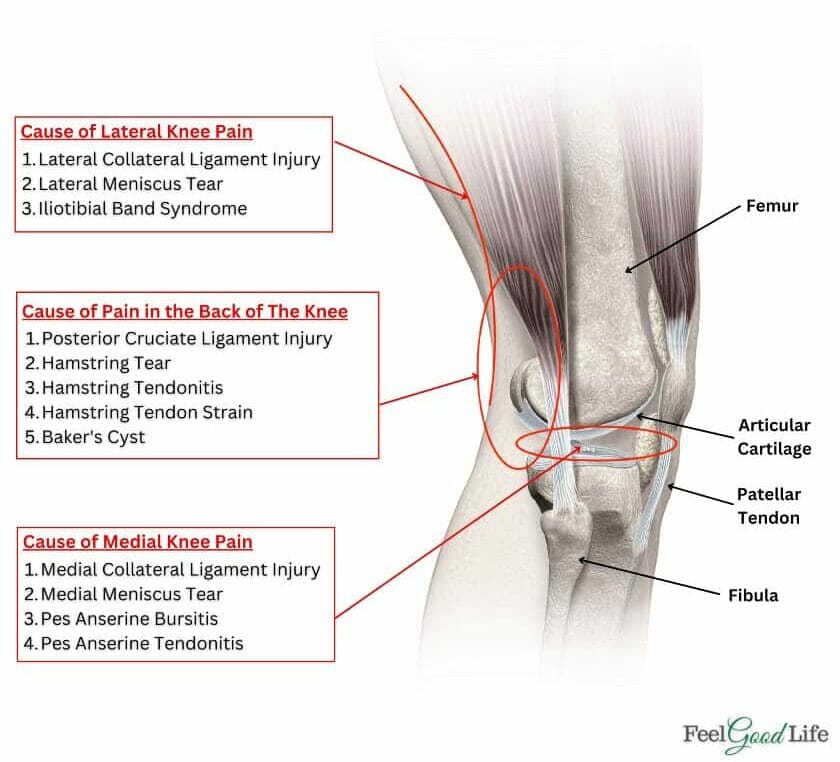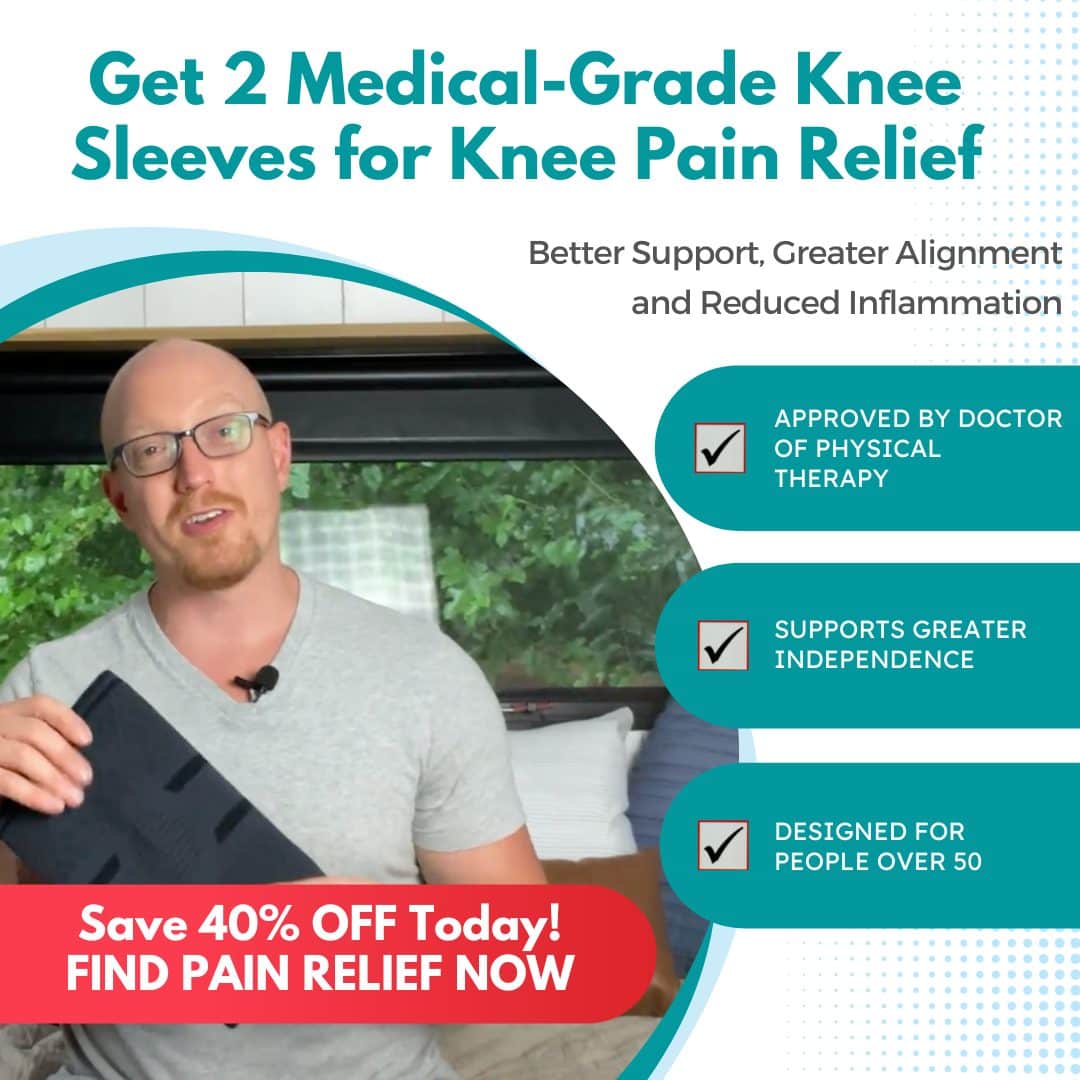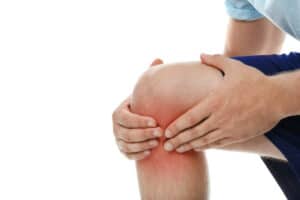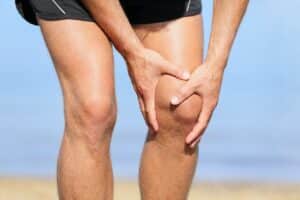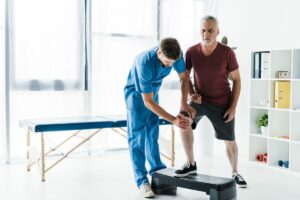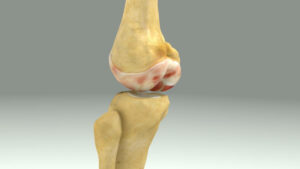Free download: Top 10 Natural & Easy Remedies for Joint Pain from Home. Learn these helpful remedies.
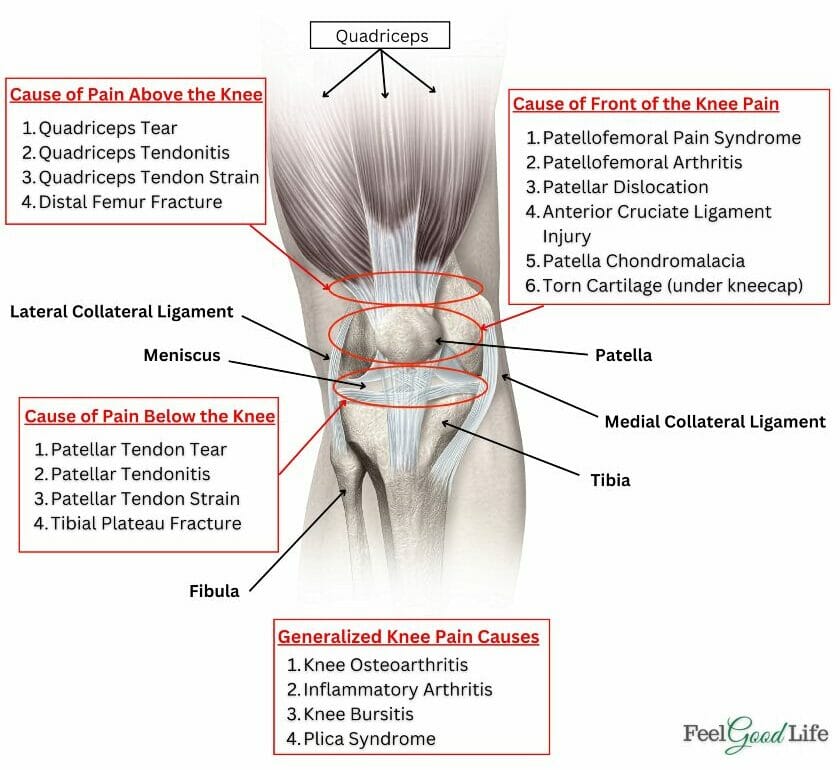
Have you ever experienced random knee pain and can’t quite figure out what it is?
Maybe you tweaked it running that extra half mile… Could it be some type of arthritis?…
Whatever the case may be, knee problems can be a real drag. It’s even more frustrating when you know where your knee pain location is, but still have no idea what it is.
Seeing as there are so many possible reasons behind knee pain or a knee injury, why not use a knee pain location chart to help narrow the suspects down??
Well get excited because that’s exactly what we’re going to do!
Table of Contents
Possible Causes of Knee Pain Based on Location
We’ll be breaking down different areas of knee pain and taking a look at possible causes of knee pain in these areas utilizing a knee pain location chart.
A. Pain in the Front of the Knee
The following are common knee pain diagnoses that have the potential to cause knee pain in the front of the knee:
1. Patellofemoral Pain Syndrome
Patellofemoral pain syndrome is a common diagnosis give when someone is experiencing general pain around the front of the knee. This type of injury commonly occurs from overuse injuries and repetitive stress versus a trauma, such as a fracture.
Also known as runner’s knee, it’s a common source of pain for those who participate in sporting activities that involve running and/or jumping. It also can occur though due to a change or increase in activity level, such as with excessive walking, squatting or stair climbing.
Symptoms:
This pain can feel like a dull pain or ache in the front of the knee. It will usually get worse with activity and positions that place more pressure on the knee, such as running, walking, stair climbing, kneeling or squatting. Even prolonged sitting can be painful.
2. Patellofemoral Arthritis
Arthritis is a natural degenerative process that can affect any joint in the body, including the kneecap, or patellofemoral joint.
With this type of arthritis, the articular cartilage will tend to wear down significantly. This can lead to inflammation and cause greater friction forces under the kneecap.
A previous history of injury or structural abnormalities, such as an obvious deformity, to this joint can increase your odds of developing patellofemoral arthritis. This may include a previous patellar fracture or natural misalignment of the kneecap, contributing to abnormal movement mechanics and increased friction forces.
Symptoms:
This pain will commonly affect most standing activities, similar to patellofemoral pain syndrome, such as walking, running, stair climbing, kneeling and squatting.
You may notice increased pain and stiffness after prolonged sitting, especially once you stand and begin to move. After walking for a bit, this sensation may improve, but with prolonged walking pain will worsen.
The pain may feel like a dull ache. There can be associated cracking, or crepitus, under the kneecap. You may even experience swelling.
3. Patellar Dislocation
The kneecap, or patella, is situated in a vertical groove at the knee joint. If the patella moves out of this groove, it’s considered a patellar dislocation.
Patellar dislocations are commonly caused by a trauma, such as a car accident or fall. If you’re naturally hypermobile, this could also be a contributing factor increasing your chances of a patellar dislocation. Some can be born with incorrect patellar alignment and placement.
A partial dislocation is considered more of a subluxation. The kneecap is still technically in its groove, but is not stable. If it pops completely out of position and stays that way, then it’s considered a dislocation.
Symptoms:
With a patellar dislocation, you may hear or feel a pop in the knee cap when it occurs. Severe knee pain in the front of the knee is usually immediate. The knee may try to buckle or lock up on you.
It will usually be very difficult to walk or bear weight on the leg. You may even see the patella out of alignment and feel knee instability.
4. Anterior Cruciate Ligament Injury
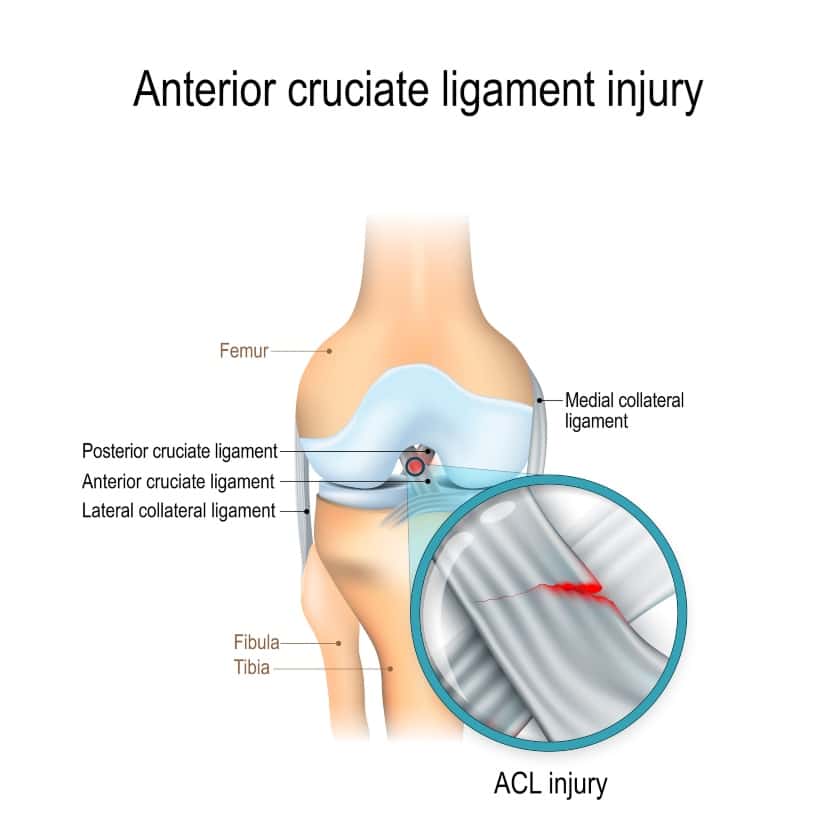
The anterior cruciate ligament (ACL) is one of the major ligaments of the knee. An ACL injury is a common knee injury, particularly among athletes.
An ACL injury can involve a mild sprain of the ligament or an ACL tear. A tear can be partial or a complete tear.
An ACL injury will commonly occur during activities or sports that require sudden stops or twists, running and jumping.
Symptoms:
With an ACL injury, especially a tear, you will usually feel and/or hear a pop in the knee. Pain is usually sudden and intense. You may notice immediate knee swelling. The knee will feel unstable and bearing weight on the leg will be difficult.
Reduced knee range of motion, stiffness and weakness often accompany an ACL injury.
If, however, you’ve experienced a milder ACL sprain, the pain intensity will usually be less severe, and limitations at the knee won’t be as major.
The pain itself will likely still favor the front of the knee but may feel like more of a deep pain versus a superficial sensation.
5. Patella Chondromalacia
Patella chondromalacia occurs with softening and wearing down of the knee cartilage behind the kneecap.
Previous injuries to the patella, abnormal kneecap positioning or muscle imbalances, being overweight, and activities or sports that involve repetitive high impact forces to the patella (e.g., running and jumping) can increase risk for development of patella chondromalacia.
Symptoms:
It’s common to experience knee pain around the patella or kneecap with this issue. The pain will normally be a dull ache. Pain is worse with end range knee flexion or bending of the knee.
Extended walking, squatting and climbing stairs is usually painful. The knee may feel like it’s clicking or grinding under the kneecap. Pain can also occur when you stand after having sat for a while.
6. Torn Cartilage (under kneecap)
A knee cartilage tear can occur as a result of a sports injury or from natural wear and tear of the cartilage as we age.
As cartilage wears down over time, any motion or position that places additional stress on the knee, such as extreme bending or twisting of the knee, can cause a cartilage tear.
Symptoms:
The pain associated with a knee cartilage tear can either be sudden or gradual.
Sometimes, especially if related to a sports injury, you may notice sudden onset of pain felt around the front of the knee or under the kneecap immediately. There is the possibility that, if due to natural wear and tear, pain may begin more gradually and is present off and on.
Either way, you may also notice aching, buckling of the knee, a lack of knee stability, difficulty bearing weight on the leg, reduced knee range of motion, swelling, and tightness.
B. Pain in the Back of the Knee
The following are possible knee pain diagnoses that may cause pain in the back of the knee:
1. Posterior Cruciate Ligament Injury
The posterior cruciate ligament (PCL) is another major ligament inside the knee. It’s situated behind the ACL. While injury to the PCL is not as common, it still can occur.
A PCL injury will more commonly occur with injury to another of the knee ligaments.
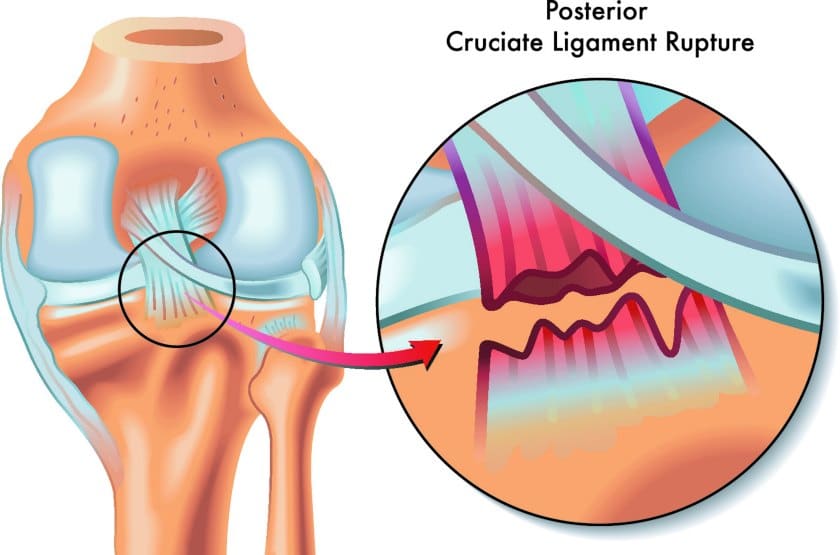
Athletes involved in contact sports are most susceptible to injuring the PCL, such as with soccer and football; however, any type of trauma or stress to the ligament can potentially cause a PCL injury.
The PCL can experience a mild sprain, partial tear or complete tear.
Symptoms:
Depending on the cause of the PCL injury and severity of it, pain may come on immediately or gradually. If it is gradual, it will tend to worsen over time if not treated properly.
You may notice pain and stiffness in the back of the knee, reduced knee range of motion, feeling of instability in the knee, difficulty with weight bearing activities such as walking and climbing stairs, and swelling.
2. Hamstring Tear
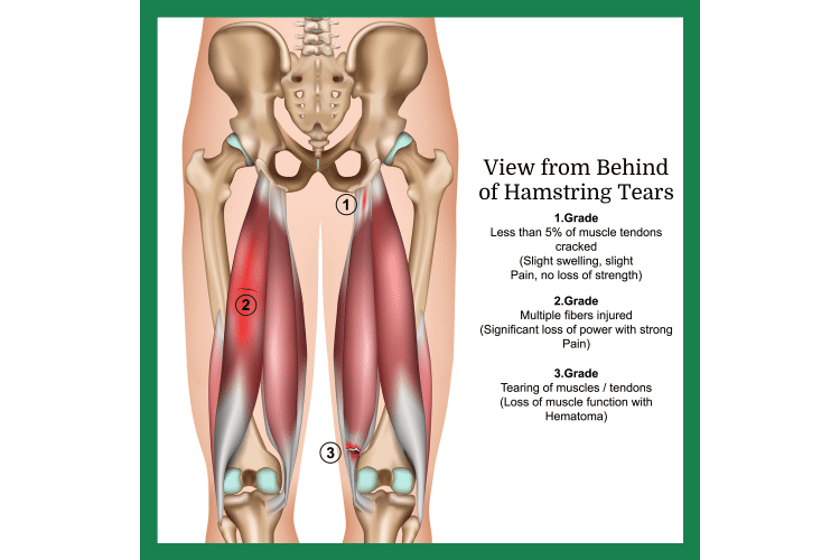
Any hamstring muscle is susceptible to a tear: biceps femoris, semitendinosus, semimembranosus. The hamstrings connect to the back of the knee and hip via their tendons.
A hamstring tear is very common in athletes but can also occur outside of a sports injury.
Other possible causes can include placing the hamstrings in a position that causes excessive stress or load, especially if the hamstrings are already weak or tight.
Repetitive stress over time, such as with runners or dancers, can cause a tear to occur.
Symptoms:
Usually, a hamstring tear will occur suddenly. This will tend to be a strong, sharp sensation in the back of the knee.
You may notice swelling and bruising, along with trouble walking and bending the knee. Realistically, any activity that has you putting weight on the leg will cause more pain.
3. Hamstring Tendonitis
Hamstring tendonitis can also occur in any hamstring tendon. Each hamstring tendon connects each hamstring muscle to the back of the knee.
Hamstring tendonitis is commonly caused from repetitive stress or overuse injuries, but this is not as severe of an injury as a hamstring tear.
This also can occur in athletes, particularly sports that involve running and jumping. Those who have underdeveloped or muscle imbalances in the hamstrings (e.g., excessive weakness and/or tightness) are susceptible to hamstring tendonitis.
Hamstring tendonitis will develop gradually over time.
Symptoms:
A dull ache in the back of the knee. You’ll notice stiffness in the back of the knee while walking and bending the knee. There may possibly be mild swelling.
If you place the hamstrings in a stretched position, this may cause a sudden increase in intense pain behind the knee. You’ll still be able to walk, but due to difficulty using the knee properly, the hamstrings may feel weak and walking distance may be limited.
4. Hamstring Tendon Strain
Hamstring tendon strains typically occur due to high levels of movement or mechanical stress. This commonly occurs in sports or activities that may require any type of running or jumping.
The strain can occur as a result of a sudden contraction or extreme stretch of the hamstrings. A strain could also develop over time due to repetitive, higher stress forces, such as running.
A mild strain usually involves micro-tears in the tendon but can be moderate or severe enough to cause a partial or full tear or tendon rupture, respectively.
A hamstring muscle imbalance, such as weakness and/or strength, can make you more susceptible to a strain.
Symptoms:
With a hamstring strain, you could notice either immediate, intense pain or more of a gradual pain onset if it has occurred from repetitive stress over time versus a single incident.
You may notice bruising and swelling behind the back of the knee, along with pain and tenderness behind the knee. Depending on the severity of the strain, you may notice stiffness and limited ability to bend the knee.
Activities such as walking, squatting, and climbing stairs can be a challenge.
5. Baker’s Cyst
A Baker’s cyst is a growth that develops behind the knee and is filled with fluid. This is different than a bursa, as a cyst is not a normal part of the anatomy.
This may develop due to wear and tear in the knee joint, such as is related to arthritis or wearing down of cartilage.
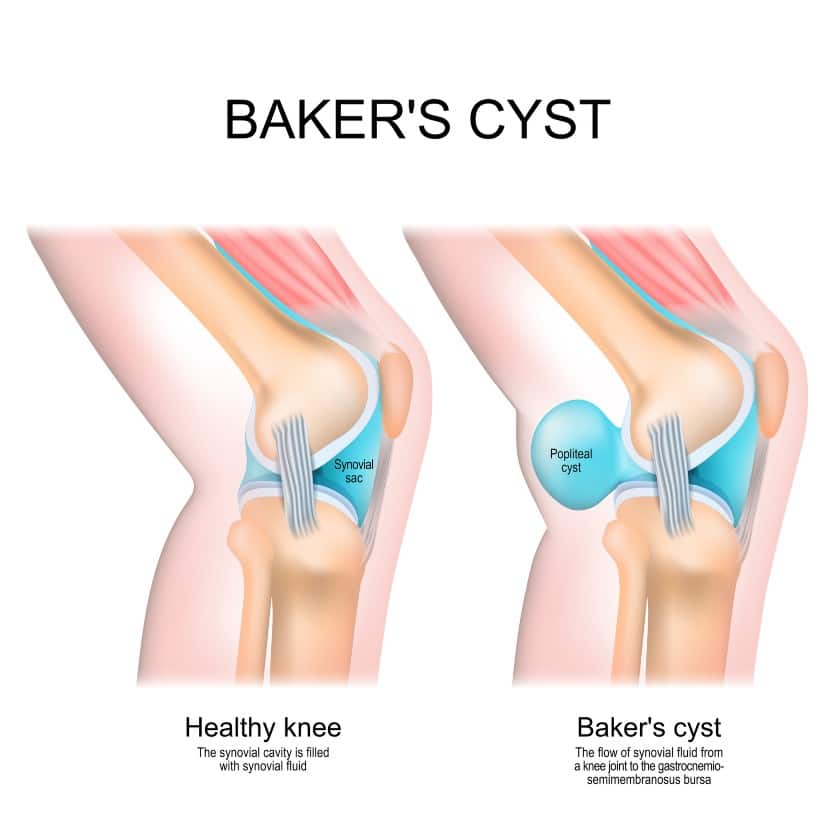
Symptoms:
A Baker’s cyst will usually cause tightness and pressure behind the back of the knee. This knee pain can be present with both knee bending and straightening. You may be able to feel a tender bulge behind the back of the knee where the cyst is located. Some swelling may be present around the cyst.
C. Pain Above the Knee
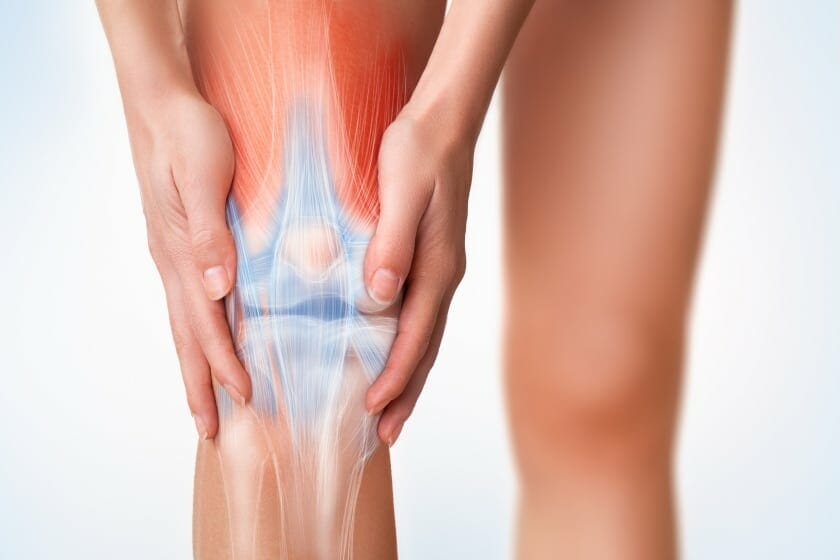
The following are possible diagnoses that could be causing pain just above the knee:
1. Quadriceps Tear
The quadriceps are made of 4 muscles: rectus femoris, vastus medialis, vastus lateralis, and vastus intermedius. These connect to the top of the knee via their tendon attachments and help to straighten the knee.
Like all other muscles and tendons, the quadriceps can be susceptible to a tear. One or more of the muscles/tendons that make up the quadriceps can experience a tear.
A quadriceps tear can occur from a fall, any direct trauma or insult to the muscles, sports that involve running and jumping, and any weakness present in the quadriceps can make the more susceptible to injury.
Symptoms:
A quadriceps tear will usually cause immediate and intense pain just above the knee. You’ll know as soon as this happens. You may even hear and/or feel a pop above the knee.
There may also be swelling, bruising and tenderness. It will be very difficult to walk with this injury, and you likely will feel the knee buckling or giving out on you.
A partial tear may not have as severe of symptoms as a complete tear or rupture. With a complete tear or rupture, you may notice an indentation just above the knee.
2. Quadriceps Tendonitis
Quadriceps tendonitis is caused from overuse or repetitive use of these muscles. This commonly occurs with activities such as walking, running, or stair climbing.
This tendonitis will develop gradually over time versus all at once. Overuse of this area will create inflammation around the quadriceps tendons.
Symptoms:
With quadriceps tendonitis you’ll notice tenderness when you touch the area just above the knee, as well as possibly swelling and warmth. You may notice an achy sensation above the knee and stiffness, especially in the morning or when getting up after prolonged sitting.
It will be uncomfortable and painful to walk for prolonged periods, squat, run or use stairs.Rest may temporarily relieve your symptoms.
3. Quadriceps Tendon Strain
The quadriceps tendon can experience a strain like any other tendon in the body. This can occur from a one-time severe injury, or from repetitive mechanical stress to the quadriceps over time.
While common in athletes, especially those who perform high intensity or constant running, kicking, jumping and landing, non-athletes can also experience quadriceps strains if these soft tissues are overstretched in a forceful manner.
Any muscle imbalances, such as excessive weakness or tightness in the quadriceps, can increase your chances of a strain.A mild strain will create micro-tears in the tendon. If the strain is more moderate or severe though, it can cause a partial or full tear or tendon rupture, respectively.
Symptoms:
There will either be a strong, immediate pain onset or a gradual pain onset, depending on the cause of injury.You can feel pain in the quadriceps muscle or closer to the top of the knee where the tendons attach.
There will be tenderness in these areas, possible swelling and bruising. A more severe injury may create a popping or snapping sensation at the top of the knee.Decreased knee mobility and weakness will occur.
The knee and quadriceps muscles may feel stiff when trying to move after having sat for a while.
4. Distal Femur Fracture
A distal femur fracture is a break in the thigh bone on the lower end of the thigh near the knee. This is typically caused by a trauma, such as a fall or car accident.
Those with poor bone density, such as the elderly, are considered to have a higher risk of a bone fracture, especially if a fall is involved.
Symptoms:
With a distal femur fracture, you will notice a sudden and extreme onset of pain at the time of the injury. You likely will not be able to place your full weight on the injured leg. Tenderness and swelling will usually present right away.
Depending on the type of fracture, you may or may not notice an abnormal shape to the leg after the fracture.
D. Pain Below the Knee

The following are possible diagnoses that can create pain just below the knee:
1. Patellar Tendon Tear
The patellar tendon attaches to the bottom of the kneecap. A tear to this tendon will be considered partial or complete.
A patellar tendon tear is usually caused by some sort of trauma, like a fall or abnormal landing mechanics when jumping.
There is the possibility to consider that repetitive overuse in this area will gradually wear down the tendon fibers, and if enough force presents, can make you more susceptible to a tear.
Symptoms:
Presence of tenderness, bruising, and swelling will typically accompany a patellar tendon tear. Depending on if the tear is partial or complete, there may be a small indentation at the bottom of the knee.
The kneecap itself may become unstable as it has lost one of its anchors to the shin bone. There will be knee stiffness, reduced range of motion, and trouble walking as the knee will likely buckle on you.
2. Patellar Tendonitis
Patellar tendonitis occurs from overuse. This is very common in athletes who run or jump frequently, such as soccer players, dancers, gymnasts, and cross-country athletes.
You may also hear this called jumper’s knee.
Even if you don’t participate in sports, you can still experience patellar tendonitis from repetitive walking, squatting, and stair climbing.
Symptoms:
Pain will come on gradually just below the kneecap. There will likely be tenderness, slight warmth and possible swelling in this area as well.
You’ll find it difficult to perform your day-to-day routine and sporting activities, especially anything that involves repetitive motions at the knee specifically.
Rest will temporarily relieve pain, but once you begin moving again, it will likely slowly come back.
3. Patellar Tendon Strain
A patellar tendon strain is an overstretching of the tendon fibers. This can occur from repetitive stress, such as one experiences with patellar tendonitis. Repetitive activities involving walking, running, using stairs frequently, and jumping are common causes.
A patellar tendon strain is a mild injury, compared to a more severe partial or complete tear of the tendon.
Symptoms:
As a patellar tendon strain is slightly more severe than tendonitis, you would notice mild to moderate pain just below the knee. Tenderness, bruising, and swelling may all be present.
It will be difficult to bend the knee, as well as perform any motions that involve squatting, jumping or stairs. You likely will be able to walk with a strain, but it can be painful. You may not notice buckling such as with a partial or complete tear.
4. Tibial Plateau Fracture
A tibial plateau fracture involves a break in the upper portion of the shin bone. This is usually the result of a high impact, traumatic force, such as a fall, car accident, or sports injury.
Symptoms:
With a fracture in this area, you’ll notice sudden and intense pain below the knee at the top of the shin. Swelling and stiffness are common. You will likely be unable to bear any weight on the injured leg due to pain and instability.
E. Medial Knee Pain
The following are potential diagnoses that would create pain on the medial, or inside, of the knee:
1. Medial Collateral Ligament Injury
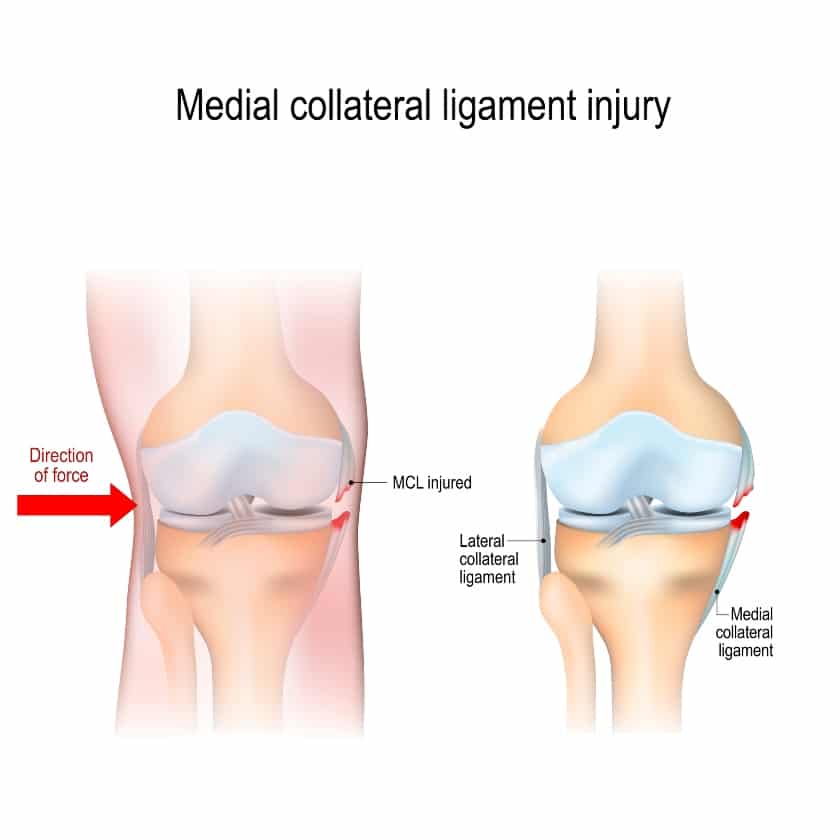
The medial collateral ligament (MCL) helps to stabilize the inside of the knee.
An MCL injury is a very common injury among athletes, such as with football, basketball and soccer.
Non-athletes can experience an MCL injury if an abnormal force or pressure is placed on the inside of the knee, such as with a twisting injury or fall.
Structural abnormalities, such as being knock-kneed, can create excess stress naturally on the inside of the knees. This can add greater susceptibility to an MCL injury.
The MCL can experience a mild sprain or can be more severe, such as with a partial or complete tearing of the ligament.
Symptoms:
Symptoms will involve medial pain and tenderness on the inside of the knee. The knee may feel stiff and could be swollen. While walking, the knee could try to lock or buckle on you.
A milder sprain will typically have less pain, and you can normally still walk with it. A partial or complete tear will limit your ability to walk and bear weight on the leg more significantly due to pain and knee instability.
2. Medial Meniscus Tear
A medial meniscus tear can occur from a sudden trauma, especially a twisting injury, or blow to the knee.
It can also occur as a result of gradual degeneration of the meniscus, leading it to a higher susceptibility of tearing with repetitive motions at the knee over time.
Symptoms:
Medial pain at the knee, along with tenderness at the medial knee joint line, will occur. You may feel like the knee catches or locks when walking. It can be hard to full straighten the knee due to pain, tenderness and swelling.
Any twisting or rotating motion that places additional stress on the medial meniscus will increase pain.
Walking may also be limited due to a lack of support and sensation of instability, causing the knee to buckle or give way.
3. Pes Anserine Bursitis
Pes anserine bursitis occurs when the bursa located between the shin bone and the tendon attachments at the medial knee of the sartorius, gracilis, and semitendinosus becomes inflamed.
This is commonly caused from overuse and repetitive stress to this area. Runners and those with knee osteoarthritis are among the most susceptible to pes anserine bursitis.
Symptoms:
This is more of a slow, gradual pain that develops on the inside of the knee. There will be tenderness to touch, possible swelling and warmth in the area.
Pain will worsen with continued activity, including walking, stair climbing, running, etc.
Rest may temporarily relieve symptoms, but if enough recovery time is not allowed, pain will resume with your normal activities.
4. Pes Anserine Tendonitis
Pes anserine tendonitis is a repetitive, overuse injury at the site where the tendons of the 3 muscles that create the pes anserine meet.
Similar to pes anserine bursitis, runners are a common victim of this injury. It’s also likely to experience this type of tendonitis if you have degenerative changes in the knee, such as arthritis.
Anatomical abnormalities can also make you susceptible to this tendonitis, such as having flat feet or being knock-kneed.
Symptoms:
You will notice pain, tenderness, pressure and tightness on the inside of the knee. The knee will feel stiff, and make tasks such as walking, running, squatting and using stairs difficult.
It’s not uncommon to experience swelling and notice slight warmth over the area of pain.
Sitting and rest can briefly relieve symptoms, but pain usually returns once you’re up and moving again.
F. Lateral Knee Pain
The following are possible diagnoses that can create knee pain on the lateral, or outside, aspect of the knee:
1. Lateral Collateral Ligament Injury
The lateral collateral ligament (LCL) is located on the outside of the knee and assists in stabilizing the knee joint.
The LCL can experience a mild sprain, partial or complete tear.
Athletes remain at a higher risk for this type of injury, especially if the sport requires running, jumping, twisting and sudden stops or changes in direction.
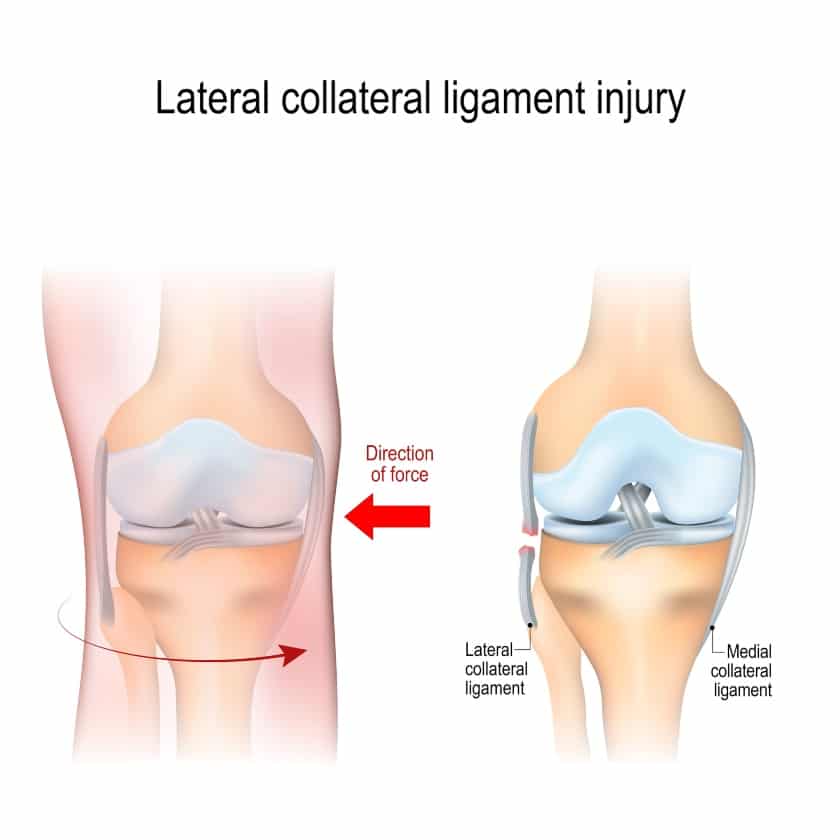
Non-athletes can still injure the LCL if any abnormal stress or force is applied to the outer knee.
Symptoms:
Lateral pain, swelling and tenderness will be present with an LCL injury. Any weight bearing activity, such as walking, will make the knee feel unstable. The knee may try to give way or buckle while standing on it or walking.
The knee will feel stiff when bending and straightening it.
2. Lateral Meniscus Tear
A lateral meniscus tear, similar to the medial meniscus, will occur either suddenly or gradually over time.
Sudden tears are normally from forceful twisting motions at the knee, particularly when the foot is planted on the ground, or from any other type of trauma or blow to the lateral knee, such as a fall.
Degenerative changes in the knee joint can also cause a progressive tear in the lateral meniscus. This is common with arthritic changes.
Anatomical abnormalities that place additional stress to the outside of the knee, such as being bow-legged, can place an increased risk of experiencing a lateral meniscus tear.
Symptoms:
If due to a sudden trauma or injury, you will notice immediate, intense pain at the lateral or outer knee. If caused by gradual degenerative changes, the pain may come on more slowly and gradually.
There will be outer knee pain, tenderness to touch, and likely swelling.
The knee will feel unstable and may try to buckle while weight bearing, such as with walking. Stiffness will be noticeable when bending and straightening the knee. You may hear or feel clicking in the outside of the knee as well.
3. Iliotibial Band Syndrome
The iliotibial band (IT band) has an attachment point just below the knee on the outside of the leg.
If the IT band becomes too tight for any reason, it can rub and create friction forces over its bony attachment just below the outside of the knee.
Runners and bicyclists can commonly experience IT band syndrome. Any sport or recreational activity that involves any type of running can create an increased risk for IT band syndrome.
Non-athletes can also experience IT band syndrome. There is an increased risk if muscle imbalances in the hip, thigh or knee are present or with structural abnormalities, such as being bow-legged, having one leg longer than the other, or knee arthritis.
Symptoms:
IT band syndrome will typically cause outer knee pain and tenderness. You may notice a clicking or rubbing sensation on the outside of the knee.
Pain will usually worsen with activity and improve with rest initially. If this issue continues without treatment though, then pain may become more constant no matter what you’re doing.
G. Generalized Knee Pain
1. Knee Osteoarthritis
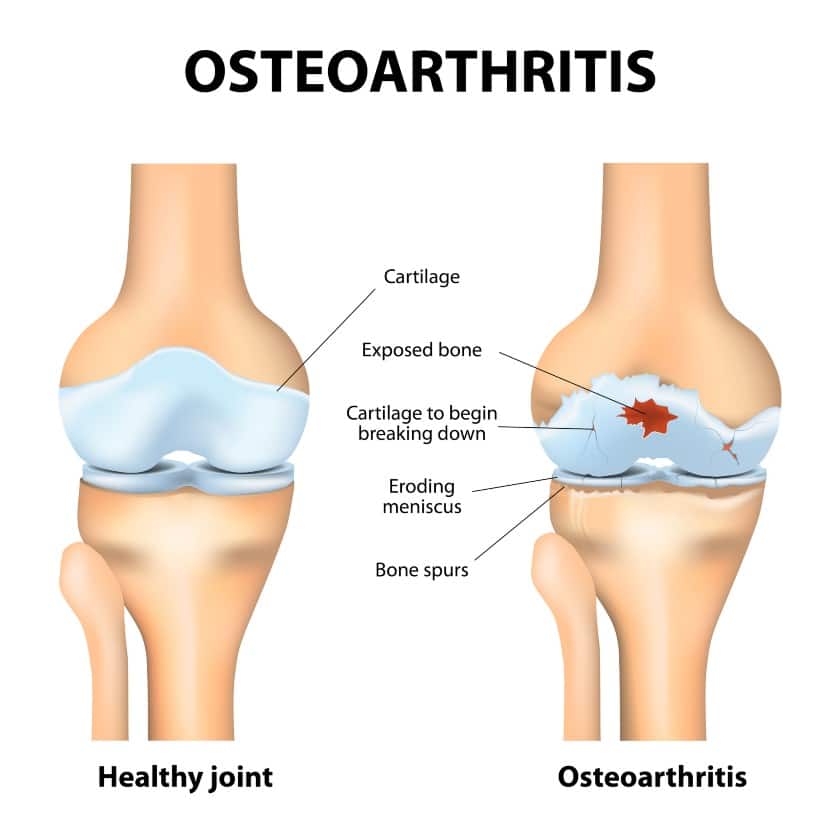
Knee osteoarthritis is a severe form of knee joint arthritis that develops from gradual wear and tear over many years.
This is most common in older adults. It’s thought that a prior history of one or more knee injuries, could make you more susceptible to develop knee osteoarthritis.
Repetitive stress on the knee or natural anatomical abnormalities can increase chances of developing knee osteoarthritis.
Additionally, being overweight or obese can place additional stress and strain on the knees and add susceptibility to developing arthritic changes.
Symptoms:
A general, deep ache in the knee is common with knee osteoarthritis. The knee will feel stiff in the mornings and when initiating standing after prolonged sitting.
There may be reduced knee range of motion and decreased strength. Pain may come and go and remain constant, depending on how severe the arthritic changes are.
Prolonged walking, standing, squatting and stair climbing usually painful.You may also notice intermittent swelling and warmth around the knee.
2. Inflammatory Arthritis
Inflammatory arthritis is an umbrella term for a group of conditions that develop from an overactive immune system.
Conditions under this category can include rheumatoid arthritis, psoriatic arthritis, juvenile idiopathic arthritis, ankylosing spondylosis, and gout.
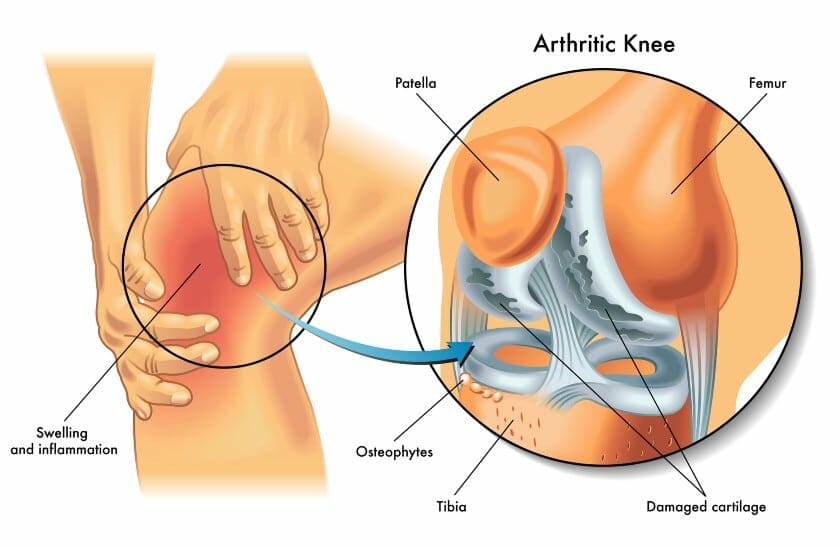
Some autoimmune diseases will have inflammatory arthritis as a symptom rather than the sole diagnosis, such as with lupus.
Symptoms:
While inflammatory arthritis will cause more general knee pain, you’ll also experience widespread body pain. This is one of the ways that inflammatory arthritis can be differentiated from knee osteoarthritis.
You will experience knee pain, swelling, warmth, and tenderness. The knee may feel stiff and difficult to move.
As this is due to widespread inflammation, pain may be more constant and not relieved with rest. One may notice difficulty with most activities, including walking, standing, prolonged sitting, squatting and using stairs.
3. Knee Bursitis
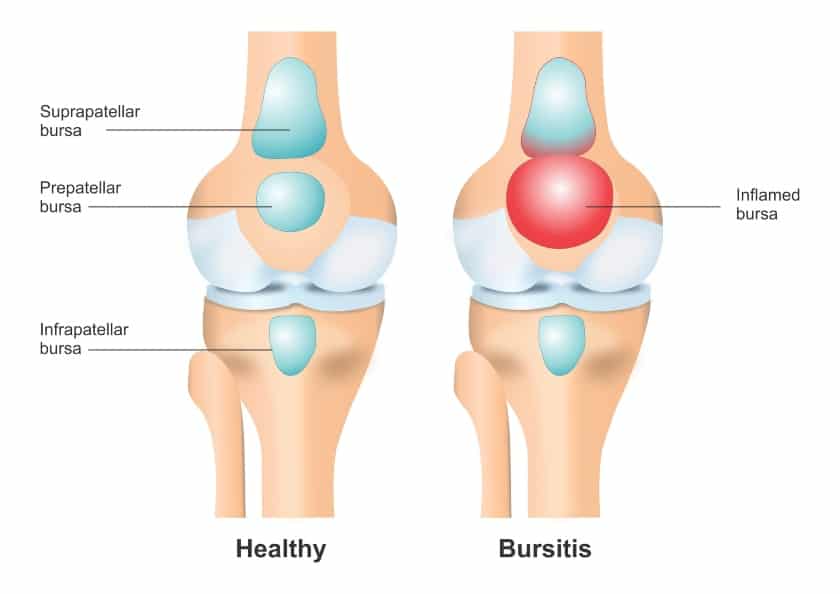
Remember that bursae are fluid filled sacs that surround many joints and bony surfaces in the body, including the knee.
Knee bursitis occurs due to inflammation in the bursae. This bursitis can occur anywhere around the knee, due to multiple knee bursa sacs being naturally present.
Knee bursitis can occur from overuse, such as walking or repetitive kneeling. While a trauma to the knee can also contribute to bursitis, repetitive motions that place excessive force and pressure over the front of the knee are most common.
Symptoms:
Unless you’ve had a specific and direct trauma to the knee, bursitis will usually come on gradually. Seeing as there are multiple bursae around the knee joint, sometimes the pain location can vary. You will notice knee tenderness, swelling, and possibly some warmth.
Pain can be present in motion or at rest.
4. Plica Syndrome
Any or all of the 4 plicae in the knee can experience pain and inflammation.
The 4 plicae include the suprapatellar plica, infrapatellar plica, medial plica, and lateral plica.
Your exact pain location really will depend on which plicae are affected. Medial plica syndrome is considered most common.
If you have suprapatellar plica syndrome, you may have pain just above the kneecap. Infrapatellar plica syndrome just below the kneecap. Medial plica syndrome on the inside of the knee. Lateral plica syndrome on the outside of the knee.
Plica syndrome can develop gradually as a result of repetitive stress and motions, such as running, bicycling, climbing stairs, and walking. A sudden increase in your activity level with the activities listed above can also contribute to inflammation in the plicae.
This syndrome can also develop as a result of a direct trauma, such as a fall or twisting of the knee.
Muscle imbalances, particularly in the quadriceps, can make you susceptible to increased plicae irritation.
Finally, any other underlying issues in the knee joint that may add extra stress to the plicae can lead to plica syndrome.
Symptoms:
As mentioned above, the exact location of your plica syndrome pain will depend on which plica or plicae are inflamed.
Pain will feel like an ache. There can be swelling around the knee. Swelling can cause stiffness in the knee, making it feel tight.
You might notice clicking or popping around the knee, especially when you move the knee or walk on it. The knee may not feel as stable as normal while walking or standing. Other activities, such as squatting and taking stairs will be more challenging. The knee may also feel like it could lock up while trying to use it.
Putting it Altogether
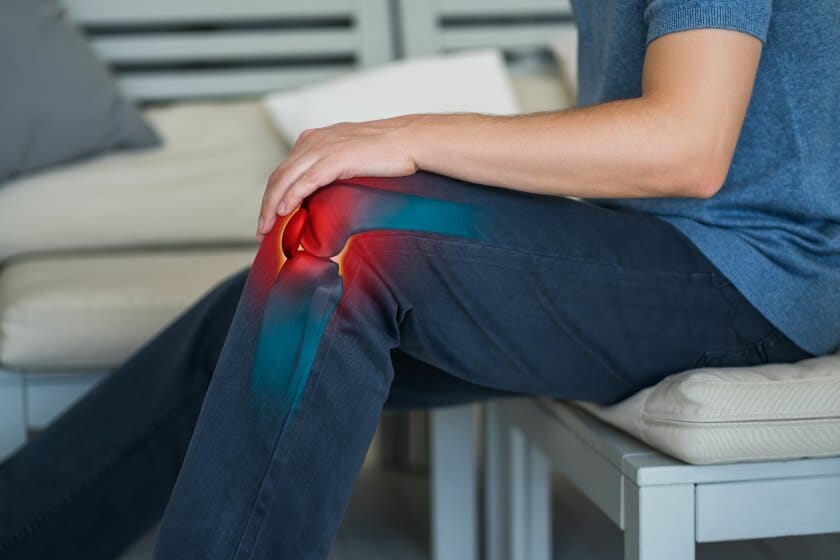
As you can see, there are a lot of possible causes behind knee pain!
Recognizing and identifying your knee pain location, as well as what could occur in that area to cause knee pain, is very important to help determine the right course of treatment.
A knee pain diagram or knee pain location chart isn’t meant to take the place of seeing a healthcare provider. The primary purpose is to help educate about possible causes of knee pain based on its location.
Knowing and understanding more about your knee pain will help you better understand the course of treatment that may be needed and how to prevent knee pain from occurring in the first place.
FAQ:
When should I see a medical professional for my knee pain?
If you’ve had a traumatic injury that’s caused your knee pain, then you should see someone immediately.
If you have more mild symptoms that gradually started but have not improved with rest and home treatment after 1-2 weeks, then make an appointment with a healthcare professional.
Who should I see about my knee pain?
If the pain is related to a trauma and you’re having severe pain, then you really should go to the ER to see what is happening. Otherwise, an orthopedic physician, who specializes in knees, would be the best to see.
Should I wear a knee brace for my knee pain?
Sometimes a brace can be helpful for initial pain management and to help you keep moving, but long-term you don’t want to rely on it. As you begin your rehab for your knee, you’ll want to try to wean away from using a brace regularly and make your knee learn how to support itself again.


